27 June 2019 was a significant day in our history as the UK became the first major economy in the world to pass laws to end its contribution to global warming by 2050.
The target will require the UK to bring all greenhouse gas emissions to net zero by 2050.
As the new legislation was signed, Energy and Clean Growth Minister Chris Skidmore said:
“The UK kick-started the Industrial Revolution, which was responsible for economic growth across the globe but also for increasing emissions. Now we’re leading the world yet again in becoming the first major economy to pass new laws to reduce emissions to net zero by 2050 while remaining committed to growing the economy – putting clean growth at the heart of our modern Industrial Strategy.
We’re pioneering the way for other countries to follow in our footsteps driving prosperity by seizing the economic opportunities of becoming a greener economy.”
Now, this really is fantastic news for the environment, supporting the need to reduce climate change by taking the right steps to make the world a better place for our future generations.
But, what does it all mean in real terms?
Is it a realistic target? Can we actually make a difference as individuals, or is this something that can only be addressed by Governments and large corporations? Won’t it all cost a lot of money to implement?
There are so many questions, but the only one that we genuinely know the answer to right now is that if we continue as we are, climate change will continue at pace and we, as a society will continue to contribute to the ultimate destruction of our planet. It all sounds very dramatic and depressing, so let’s explore the evidence and work out what we can all do to help the UK (and hopefully the rest of the World) meet this ambitious target.
Let’s take a look at a few facts and figures:
Renewables are on the rise – the use of renewable energy is continuing to grow, and will account for almost 30% of total power demand globally by 2023.
Source: IEA
Coal consumption is declining – from 157m tonnes in 1970 to just 11.8m tonnes in 2018, and the UK’s seven remaining coal power stations set to close by 2025.
Source: BEIS/National Grid ESO
Offshore wind capacity is increasing – the Government is expecting offshore windfarms to provide a third of our electricity by 2030, with the World’s biggest offshore windfarm, Hornsea One, due to be completed in 2020. Covering an area five times the size of Hull, the 174 turbines will power 1m homes.
Source: BEIS


